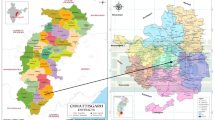Abstract
This study has been conducted during the 2015–2016 period in Aksaray, with semi-arid climate conditions, with the purpose of defining the morphologic, yield and phytochemical parameters of ’Damaye’ and ‘NQ-7’ Goji Berry varieties. The trial was conducted with ‘Damaye’ and ‘NQ-7’ varieties in randomized blocks experimental design, with three repetitions and 10 plants in each repetition, tubed saplings in every 3 m × 2 m intervals, during the years 2015 and 2016. Morphologic and yield parameters such as plant stem diameter, plant crown height, plant shoot size, plant size, yield per plant, yield per decare, yield efficiency, 100 grain weight and phytochemical parameters such as antioxidant ratio, total phenolic matter quantity, C vitamin quantity, glycose quantity, fructose quantity and sucrose quantity were examined. In the study, year × variety interaction was found to be statistically meaningful at a rate of 5% in plant stem diameter, plant crown width, plant crown height, plant size, yield per plant, yield per decare parameters; while year was found to be statistically meaningful at a rate of 5% in plant crown width, plant shoot size and yield efficiency parameters. And in terms of phytochemical properties, the difference between varieties were found to be statistically insignificant. In 2015, the average plant stem diameter (4.01 mm), plant crown height (71.12 cm), plant size (84.27 cm), yield per plant (0.22 kg/tree) and yield per decare (47.71 kg/decar) values of ‘Damaye’ variety were observed to be higher than the ‘NQ-7’variety. In 2016, the average plant stem diameter (15.12 mm) and plant size (167.50 mm) values were higher in ‘Damaye’ variety, while the average yield per plant (2.12 kg/tree) and average yield per decare (468.29 kg/decar) values were higher in ‘NQ-7’variety. As for plant corolla height, both ‘NQ-7’ (114.73 cm) and ‘Damaye’ (105.06 cm) varieties were ranked first and statistically placed within the same group. In conclusion, in 2015 ‘Damaye’ variety displayed a better performance in terms of morphologic and yield parameters, while in 2016, ‘NQ-7’variety displayed a better performance. But in both years, yield efficiency and yield per decare values were higher in ‘NQ-7’variety when compared to the ‘Damaye’ variety.
Similar content being viewed by others
References
Abdulkasım P, Songchıtsomboon S, Techagumpuch M, Balee N, Swatsıtang P, Sungpuag N (2007) Antioxidant capacity, total phenolics and sugar content of selected Thai health beverages. Int J Food Sci Nutr 58(1):77–85
Anonymous (2011) Çed Hizmetleri ve Çevre İzinleri İşleri Şube Müdürlüğü, Aksaray İl Çevre Durum Raporu, p. 242
Anonymous (2016) http://pegasus-bio.gr/en/cultivations/goji-berries
Bartolome AP, Ruperez P, Fuster C (1995) Pineapple fruit: Morphological characteristics, chemical composition and sensory analysis of red Spanish and smooth cayenne cultivars. Food Chem 53:75–79
Bensky D, Clavey S, Stöger E (2004) Chinese herbal medicine: Materia Medica, 3rd edn. Eastland Press, Seattle. ISBN 978-0939616824
Cemeroğlu B (2010) Gıda Analysis vol 34. Food Technologies Association, Ankara
Dzhugalov H, Lichev V, Yordanov A, Kaymakanov P, Dimitrova V, Kutoranov G (2015) First results of testing goji berry (Lycium barbarum L.) in Plovdiv Region, Bulgaria. Sci Pap Ser B Hortic 59:47–50 (http://horticulturejournal.usamv.ro/pdf/2015/art7.pdf)
Endes Z, Uslu N, Özcan MM, Er F (2015) Physico-chemical properties, fatty acid composition and mineral contents of goji berry (Lycium barbarum L.) fruit. J Agroaliment Process Technol 21(1):36–40
Hampson CR, Quamme HA, Kappel F, Brownlee RT (1998) Effects of apple tree density and training system on productivity. 41 st Annual IDFTA Conference, Pasco, Washington, February 21–25
Hänsel R, Keller K, Rimpler H, Schneider G (1993) Drogen E–O. Hagers Handbuch der pharmazeutischen Praxis, vol 5. Springer, Berlin, Heidelberg, New York. ISBN 978-3642579936
Istrati D, Vizireanu C, Iordachescu G, Dima F, Garnai M (2013) Physico-chemical characteristics and antioxidant activity of goji fruits jam and jelly during storage. Ann Univ Dunarea De Jos Galati Fascicle Vi-food Technol 37(2):100–110
Klimczak I, Malecka M, Szlachta M, Gliszczyńska-Świglo A (2007) Effect of storage on the content of polyphenols, vitamin C and the antioxidant activity of orange juices. J Food Compos Analysis 20:313–322
Kulczyński B, Michałowska AG (2016) Goji berry (Lycium barbarum): composition and health effects: A review. Pol J Nutr Sci 66(2):67–75
Lu W, Jiang Q, Shi H, Niu Y, Gao B, Yu L (2014) Partial least-squares-discriminant analysis dierentiating chinese wolfberries by uplc—ms and flow ınjection mass spectrometric (FIMS) Fingerprints. J Agric Food Chem 62(37):9073–9080. https://doi.org/10.1021/jf502156n
Mencinicopschi IC, Bălan V (2013) Scıentıfıc substantiation for the introductıon, on Romanian territory, of Lycium barbarum L.: A species with sanogene properties. Agrolife Sci J 2(1):95–102
Mocan A, Vlase L, Vodnar DC, Bischin C, Hanganu D, Gheldiu AM, Oprean R, Dumitrescu RS, Crişan G (2014) Polyphenolic content, antioxidant and antimicrobial activities of Lycium barbarum L. and Lycium chinense Mill. Leaves. Molecules 19(7):10056–10073. https://doi.org/10.3390/molecules190710056
Oğuz HI, Erdoğan O (2016) A study on the development performances of goji berry (Lycium barbarum L.) Varieties. Fresenius Environ Bull 25(12):5581–5586
Potterat O (2010) Goji (Lycium barbarum and L. chinense): Phytochemistry, pharmacology and safety in the perspective of traditional uses and recent popularity. Planta Med 76(1):7–19. https://doi.org/10.1055/s-0029-1186218
Qian J, Liu D, Huang A (2004) The efficiency of flavonoids in polar extracts of Lycium chinense Mill. fruits as free radical scavenger. Food Chem 87(2):283–288. https://doi.org/10.1016/j.foodchem.2003.11.008
Steel RGD, Torrie JH, Dickey DA (1997) Principles and procedures of statistics: A biometrical approach, 3rd edn. McGraw-Hill, New York, pp 400–428
Yang R-f, Zhao C, Chen X, Chan S-w, Wu J-y (2015) Chemical properties and bioactivities of Goji (Lycium barbarum) polysaccharides extracted by different methods. J Function Food 17:903–909
Acknowledgements
We would like to extend our gratitude to HZR Fidancılık A.Ş. for their assistance in trail area and sapling procurement.
Author information
Authors and Affiliations
Corresponding author
Ethics declarations
Conflict of interest
H.İ. Oğuz, O. Erdoğan, Z. Karaşahin and O. Gökdoğan declare that they have no competing interests.
Rights and permissions
About this article
Cite this article
Oğuz, H.İ., Erdoğan, O., Karaşahin, Z. et al. Determining the Morphologic, Yield and Phytochemical Properties of ’Damaye’ and ’Nq-7’ Goji Berry Varieties Under Semi-Arid Climate Conditions. Erwerbs-Obstbau 61, 225–230 (2019). https://doi.org/10.1007/s10341-019-00420-w
Received:
Accepted:
Published:
Issue Date:
DOI: https://doi.org/10.1007/s10341-019-00420-w




